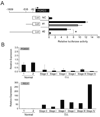Epigenetic alterations in a murine model for chronic lymphocytic leukemia
- PMID: 19901553
- PMCID: PMC2871675
- DOI: 10.4161/cc.8.22.9957
Epigenetic alterations in a murine model for chronic lymphocytic leukemia
Abstract
Early stages in the development of chronic lymphocytic leukemia (CLL) have not been explored mainly due to the inability to study normal B-cells en route to transformation. In order to determine such early events of leukemogenesis, we have used a well established mouse model for CLL. Over-expression of human TCL1, a known CLL oncogene in murine B-cells leads to the development of mature CD19+/CD5+/IgM+ clonal leukemia with a disease phenotype similar to that seen in human CLL. Herein, we review our recent study using this TCL1-driven mouse model for CLL and corresponding human CLL samples in a cross-species epigenomics approach to address the timing and relevance of epigenetic events occurring during leukemogenesis. We demonstrated that the mouse model recapitulates the epigenetic events that have been reported for human CLL, affirming the power and validity of this mouse model to study early epigenetic events in cancer progression. Epigenetic alterations are detected as early as three months after birth, far before disease manifests at about 11 months of age. These mice undergo NFkappaB repressor complex mediated inactivation of the transcription factor Foxd3, whose targets become aberrantly methylated and silenced in mouse and human CLL. Overall, our data suggest the accumulated epigenetic alterations during CLL pathogenesis as a consequence of gene silencing through TCL1 and NFkappaB repressor complex, suggesting the relevance for NFkappaB as a therapeutic target in CLL.
Figures



References
-
- Dohner H, Stilgenbauer S, Benner A, Leupolt E, Krober A, Bullinger L, Dohner K, Bentz M, Lichter P. Genomic aberrations and survival in chronic lymphocytic leukemia. N Engl J Med. 2000;343:1910–1916. - PubMed
-
- Ripolles L, Ortega M, Ortuno F, Gonzalez A, Losada J, Ojanguren J, Soler JA, Bergua J, Coll MD, Caballin MR. Genetic abnormalities and clinical outcome in chronic lymphocytic leukemia. Cancer Genet Cytogenet. 2006;171:57–64. - PubMed
-
- Stilgenbauer S, Sander S, Bullinger L, Benner A, Leupolt E, Winkler D, Krober A, Kienle D, Lichter P, Dohner H. Clonal evolution in chronic lymphocytic leukemia: acquisition of high-risk genomic aberrations associated with unmutated VH, resistance to therapy, and short survival. Haematologica. 2007;92:1242–1245. - PubMed
-
- Shanafelt TD, Witzig TE, Fink SR, Jenkins RB, Paternoster SF, Smoley SA, Stockero KJ, Nast DM, Flynn HC, Tschumper RC, Geyer S, Zent CS, Call TG, Jelinek DF, Kay NE, Dewald GW. Prospective evaluation of clonal evolution during long-term follow-up of patients with untreated early-stage chronic lymphocytic leukemia. J Clin Oncol. 2006;24:4634–4641. - PubMed
-
- Esteller M. Cancer epigenomics: DNA methylomes and histone-modification maps. Nat Rev Genet. 2007;8:286–298. - PubMed
Publication types
MeSH terms
Substances
Grants and funding
LinkOut - more resources
Full Text Sources
Research Materials
